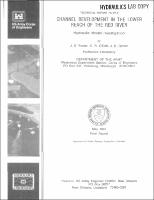Please use this identifier to cite or link to this item:
https://hdl.handle.net/11681/13283Full metadata record
| DC Field | Value | Language |
|---|---|---|
| dc.contributor | United States. Army. Corps of Engineers. New Orleans District | - |
| dc.contributor.author | Foster, James E. (James Edward), 1925- | - |
| dc.contributor.author | O'Dell, Charles R. (Charles Robert), 1943- | - |
| dc.contributor.author | Glover, James E. | - |
| dc.date.accessioned | 2016-07-18T15:22:32Z | - |
| dc.date.available | 2016-07-18T15:22:32Z | - |
| dc.date.issued | 1987-05 | - |
| dc.identifier.uri | http://hdl.handle.net/11681/13283 | - |
| dc.description | Technical Report | - |
| dc.description | Abstract: The Red River waterway provides for the development of a 9-ft-deep by 200-ft-wide navigation channel from Lake of Pines near Dangerfield, Texas, to Old River. The lower reach of the Red River with its flat slopes and narrow bends of short radii transverses the flood plain of the Mississippi River. A movable-bed model, reproducing about 4.7 miles of the Red River and a short section of the Black River to a horizontal scale of 1:120 and a vertical scale of 1:80, was used to provide an indication of the amount of maintenance dredging that would be required to: (A.) maintain a navigation channel from Lock and Dam 1 to Old River, (B.) develop a system of channel training structures to minimize the required dredging, and (C.) determine the ultimate channel section to be expected in Lorran Lake cutoff, a cutoff proposed just upstream of the mouth of the Black River. The results of this investigation revealed: (1.) The proposed overall channel was too wide to maintain a navigation channel of adequate width and depth above the Black River. (2.) The development of an adequate navigation channel in the test reach would require a reduction in the width of the overall channel. This can be obtained with dikes or by moving the banks closer together and revetting them. (3.) The first of the two plans proposed by the US Army Engineer District, New Orleans, Plan A, consisted of a 1.9-mile cutoff from mile 36.5 to 34.3 to increase the radius of the bend at the mouth of the Black River and the radius of the next bend upstream. Plan B was similar to Plan A in that it consisted of a cutoff channel in the same area; howrever, the cutoff channel for Plan B was 0.2 mile longer, and contained curves with radii at least 2,400 ft longer. Plan B, with its longer radius curves, would require less dike construction than Plan A to develop a navigation channel. (4.) Structures would be required on the left bank do1mstream of the Black River to develop an adequate channel along an alignment suitable for navigation. (5.) Structures would be required on the downstream entrance to the old bendway to maintain an access channel into the old bendway for recreation. | - |
| dc.publisher | Hydraulics Laboratory (U.S.) | - |
| dc.publisher | Engineer Research and Development Center (U.S.) | - |
| dc.relation | http://acwc.sdp.sirsi.net/client/en_US/search/asset/1003482 | - |
| dc.relation.ispartofseries | Technical report (U.S. Army Engineer Waterways Experiment Station) ; HL-87-9. | - |
| dc.rights | Approved for public release; distribution is unlimited. | - |
| dc.source | This Digital Resource was created from scans of the Print Resource | - |
| dc.subject | Red River River | - |
| dc.subject | Navigation channels | - |
| dc.subject | Training structures | - |
| dc.subject | Channel improvement | - |
| dc.subject | Hydraulic models | - |
| dc.subject | Stream channelization | - |
| dc.subject | Sediment transport | - |
| dc.subject | Sedimentation | - |
| dc.subject | Deposition | - |
| dc.title | Channel development in the lower reach of the Red River : hydraulic model investigation | - |
| dc.type | Report | en_US |
| Appears in Collections: | Technical Report | |
